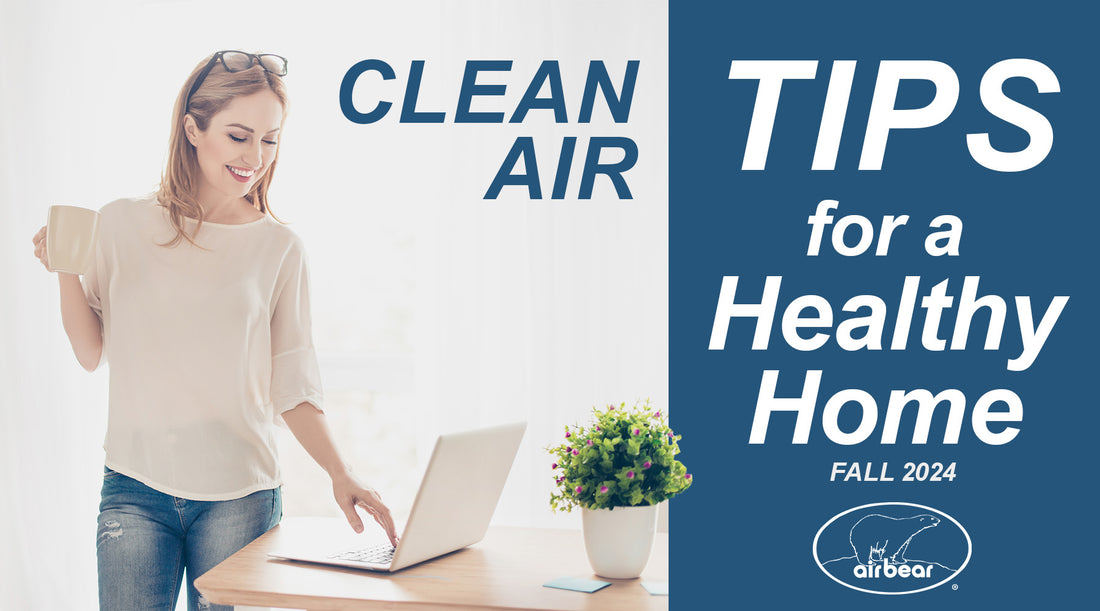
Clean Air Tips for a Healthy Home
We're all looking for ways to improve our well-being and health these days. Sometimes a few small changes can lead to great results. I've been on a bit of an indoor air quality improvement journey at my home. I live near a busy highway in the Ohio Valley. The struggle is real in the fight against allergens, pollen, pet hair and vehicle emissions.
Let's take a look at some simple steps I took, and you can too for better indoor air quality in your home.
1. Upgrade your Air Filter and Change them on a Regular Basis
Let's start with your home filtration, because hey, we manufacture and sell lots of air filters. If you are currently using a cheap filter like the one pictured below,

do yourself a favor and upgrade to at least a MERV 8 pleated Air Bear filter. This filter is going to trap more airborne particles and protect your HVAC system. If you have priced a new HVAC system lately, a quality filter is essential. Always consult your HVAC owner's manual to see what MERV rating they recommend. Remember, the higher the MERV rating the more and smaller particulates the filter is going to capture.
One question we see quite often from customers is how often should I change my filter? The answer can vary, but we recommend every 60-90 days for a 1 inch filters in rural, well-ventilated homes. Some of our 5 inch filters can go as long as 6 months in the right environments! I currently use a MERV 8 Air Bear and change it our every 60 days due to my location near lots of traffic.
Ultimately, your changeout schedule is up to you. If you're using a 1 inch filter, don't go longer than 90 days. A visual inspection of the filter can go a long was as well. Other factors to consider include:
- What is you surrounding environment like? Do you like near lots of roads and traffic like I do? It won't hurt to change out your filter more often.
- Do you have pets? If so you may want to do a changeout more frequently.
- Do you suffer from severe allergies or asthma? During peak allergy months and high pollen areas, it's not a bad idea to change your filter every 30-45 days.
Lastly, consider a portable HEPA air cleaner. Adding a quality air purifier is a great step for additional air changes and filtration in your home. The one I purchased has been awesome, it does a great job when cooking or on air quality alert days.
2. Add Some Green!
Air Bear filters and houseplants are a winning combo for improved IAQ.
House plants are a fantastic way to battle indoor pollutants and also can offer phycological benefits as well. I've added 9 houseplants to my home and they have been great!
A recent study conducted over in Australia, discovered the ability of indoor plants to eliminate toxic fumes and cancer-causing compounds. The source of the majority of the toxins were from vehicle emissions. Click Here to learn more about the study, it's pretty amazing!
I highly recommend "snake" plants or Dracaena trifasciata. Those suckers are are bulletproof and require very little maintenance. They are also easy to split as they grow. Find some nice look pots, some quality indoor soil and improve the look and air of your home.
3. Ditch the Air Fresheners
This was a tough change for me, I mean who doesn't like coming home to the smell of Ocean Harbor Mist or Lavender Vanilla? You really don't give it a second thought but unfortunately, these home air fresheners release volatile organic compounds (VOCs) which can impact your homes indoor air quality. Some of these air fresheners can contain VOC's such as formaldehyde, acetaldehyde, benzene, toluene, ethyl benzene, and xylenes. Air freshener products are not strictly regulated and there can be a wide range of ingredients and concentrations.
A collection of air fresheners I collected from family and friends that are headed to the yard sale box.
Some possible alternatives you can use include baking soda, essential oils and homemade potpourri. You can learn more about air fresheners and indoor air quality here.
4. Control Allergens, Pet Dander and Hair
If you suffer from allergies, (ragweed gets me) you can take a few steps to reduce potential allergens by vacuuming and washing bedding on a regular basis. If you have a 4 legged friend like I do, pet dander and hair can be a challenge. Not only can it work its way into your HVAC vents, it tends to pile up on the floor quickly. I invested in a robot vacuum and it has been great. I run it twice a week and it does a great job of picking up hair from my dog Bella. It saves me time from sweeping every other day. As you can see below, she's a good girl :)

5. Improve Ventilation
On nice weather days when the air quality is good and has a low pollen count, I open up several windows in my home. I turn on the kitchen and bathroom exhaust fans as well as ceiling fans to help move the air. You can create your own high number of air changes per hour by doing this. It's free to do as long as Mother Nature cooperates and hey, it gives your HVAC system a break.
I hope some of the tips I listed help you in improving your indoor air quality. Once you start to dig in and learn about simple things you can do and you make those changes, you will start to notice a difference and even feel a little better from the piece of mind and improved air quality.


